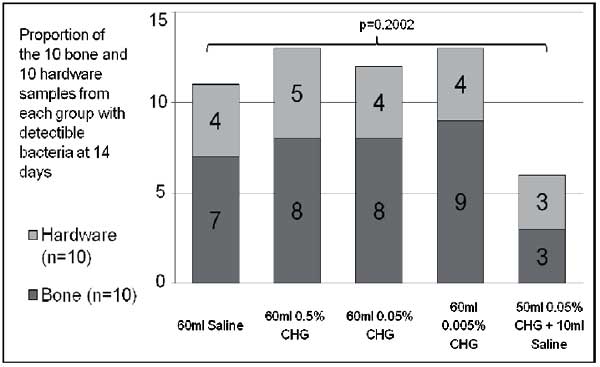
Basic Science Focus Forum
Wed., 10/12/11 BSFF: Soft-Tissue Treatment, Paper #13, 2:35 pm OTA-2011
•Comparison of Chlorhexidine and Saline for Irrigating a Contaminated Open Fracture Model
Jowan G. Penn-Barwell, MRCS1,2; Clinton K. Murray, MD3; Joseph C. Wenke, PhD1;
1US Army Institute of Surgical Research, Fort Sam Houston, San Antonio, Texas, USA;
2Academic Dept. of Military Surgery and Trauma, Royal Centre for Defense Medicine,
Birmingham, United Kingdom;
3Brooke Army Medical Center, Fort Sam Houston, Texas, USA
Purpose: Chlorhexidine gluconate (CHG) is an antiseptic that potentially combines the mechanical action of an inert fluid in physically removing bacteria with an active chemical antimicrobial effect without damaging host tissue. Interestingly, despite its reputation as a rapidly active, broad-spectrum antiseptic with low toxicity and its extensive use in most modern hospitals, CHG has not been thoroughly evaluated in either an animal model of open fracture or a clinical trial. Despite this lack of evidence, a small number of orthopaedic surgeons do irrigate open fracture wounds with 0.05% CHG solution in preference to the commonly accepted clinical standard of saline. This study compares irrigation with CHG to the clinical standard of saline in an animal model.
Methods: This study used a segmental defect rat femur model contaminated with Staphylococcus aureus and treated 6 hours after injury with débridement and irrigation with 60 mL of fluid delivered at low pressure via a hand-held syringe. In study groups of 10 animals each, 3 concentrations of CHG (0.5, 0.05, and 0.005%) were used as well as a group irrigated with 0.05% CHG then saline and a control group treated with saline only. After irrigation, animals’ wounds were closed and the rats were recovered. 14 days later, bone and hardware was harvested for separate microbiologic analysis. The primary outcome measure was detectible bacteria on bone or hardware. Quantitative cultures were also performed.
Results: Irrigation with aqueous CHG at a range of concentrations has a similar effect on infection rate to irrigation with saline alone. Initial irrigation with 0.05% CHG, followed by a saline rinse to remove CHG residue, was more effective than saline alone at reducing the infection rate but this effect did not reach statistical significance (P = 0.2). This group similarly had the lowest quantity of bacteria in the wound. The most dilute concentration of CHG tested resulted in the greatest quantity of bacteria in the wound; however, this was not significant.

Conclusion: This study demonstrates that 0.05% CHG may be an appropriate solution for irrigating open fractures provided it is rinsed from the wound prior to closure or dressing. These results appear to support the concept of a balance between antibacterial effect and tissue damage determining the overall effect of antiseptics on infection. The most dilute CHG irrigation group has the greatest amount of bacteria, consistent with this concentration being too weak to exert an antibacterial effect but still sufficient to damage tissues. Conversely, the group with the lowest infection rate and bacterial quantification was exposed to the antimicrobial effect of CHG, then had the residual CHG removed with a saline rinse. This may have possibly reduced the potential for subsequent tissue damage, which is thought to allow bacteria to thrive.
Disclaimer: The opinions and assertions contained herein are the private views of the authors and are not to be construed as official or as reflecting the views of the Department of the Army or Department of Defense.
Alphabetical Disclosure Listing (628K PDF)
• The FDA has not cleared this drug and/or medical device for the use described in this presentation (i.e., the drug or medical device is being discussed for an “off label” use). ◆FDA information not available at time of printing. Δ OTA Grant.